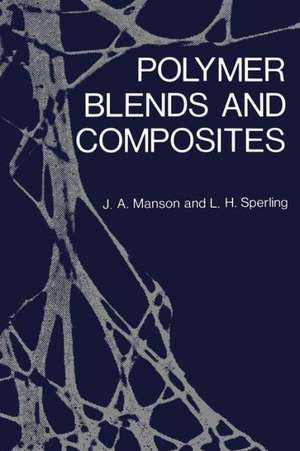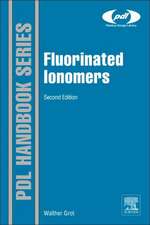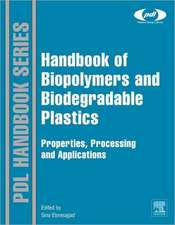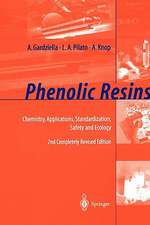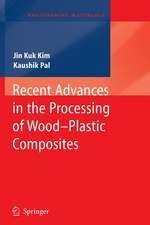Polymer Blends and Composites
Autor John A. Mansonen Limba Engleză Paperback – 5 noi 2012
| Toate formatele și edițiile | Preț | Express |
|---|---|---|
| Paperback (1) | 400.26 lei 6-8 săpt. | |
| Springer Us – 5 noi 2012 | 400.26 lei 6-8 săpt. | |
| Hardback (1) | 597.48 lei 6-8 săpt. | |
| – | 597.48 lei 6-8 săpt. |
Preț: 400.26 lei
Nou
Puncte Express: 600
Preț estimativ în valută:
76.60€ • 79.36$ • 63.93£
76.60€ • 79.36$ • 63.93£
Carte tipărită la comandă
Livrare economică 22 martie-05 aprilie
Preluare comenzi: 021 569.72.76
Specificații
ISBN-13: 9781461357100
ISBN-10: 1461357101
Pagini: 532
Ilustrații: XVII, 513 p.
Dimensiuni: 152 x 229 x 30 mm
Greutate: 0.7 kg
Ediția:1976
Editura: Springer Us
Colecția Springer
Locul publicării:New York, NY, United States
ISBN-10: 1461357101
Pagini: 532
Ilustrații: XVII, 513 p.
Dimensiuni: 152 x 229 x 30 mm
Greutate: 0.7 kg
Ediția:1976
Editura: Springer Us
Colecția Springer
Locul publicării:New York, NY, United States
Public țintă
ResearchCuprins
1. Homopolymer Structure and Behavior.- 1.1. High Polymers.- 1.2. Molecular Size and Shape.- 1.3. Molecular Structure.- 1.4. Crystallinity and Order.- 1.5. Mechanical Response: Elasticity and Viscoelasticity.- 1.6. Energetics and Mechanics of Fracture.- 1.7. Mechanical Testing of Polymers.- Appendix A. Polymer Synthesis.- Appendix B. Basic Mechanical Properties and Relationships.- Bibliography of Polymer Books and Journals.- 2. General Behavior of Polymer Mixtures.- 2.1. Methods of Mixing Polymer Pairs.- 2.2. Interdiffusion.- 2.3. Nomenclature.- 2.4. Electron Microscopy.- 2.5. The Incompatibility Problem.- 2.6. Bulk Behavior of Two-Phase Polymeric Materials.- 2.7. Analogy between Polymer Blends and Crystalline Homopolymers.- 2.8. Polymer Blend Chronology.- Appendix A. Counterpart Phase Separation Characteristics of Metallic Alloys and Inorganic Glasses.- Bibliography of Polymer Blend Symposia.- 3. Rubber-Toughened Plastics.- 3.1. Synthesis and Morphology.- 3.2. Physical and Mechanical Behavior of Polyblends.- 3.3. Optical Properties of Polyblends.- 3.4. Oxidation and Weathering of Polyblends.- 4. Diblock and Triblock Copolymers.- 4.1. Synthesis.- 4.2. Solution Behavior of Block Copolymers.- 4.3. Plastic Compositions.- 4.4. Thermoplastic Elastomers.- 4.5. Long-Range Domain Order.- 4.6. Thermodynamics of Domain Characteristics.- 4.7. Thermodynamic Criteria for Phase Separation.- 4.8. Effect of Solvent Casting on Morphology.- 4.9. Effect of Deformation on Morphology.- 4.10. Mixtures of A–B Blocks with A and B Mechanical Blends.- 4.11. Rheological Behavior of Block Copolymers.- 5. Multiblock Copolymers, Including Ionomers.- 5.1. Segmented Polyurethane Elastomers.- 5.2. Carboxylic Rubbers and Ionomers.- 6. Crystalline Block Copolymers.- 6.1. Crystallizable BlockCopolymers: Styrene-Ethylene Oxide.- 6.2. Crystallization: General Aspects.- 6.3. Kinetics of Crystallization.- 6.4. Siloxane Block Copolymers.- 6.5. Polyallomers.- 6.6. Summary of Block Copolymer Systems.- 7. Miscellaneous Grafted Copolymers.- 7.1. General Considerations.- 7.2. Surface Graft Copolymers.- 7.3. Degradation and Crosslinking Reactions.- 7.4. Grafting onto Cellulosic Materials.- 7.5. Nylon Graft Copolymers.- 7.7. Multipolymer Grafts.- 7.8. Cationic Graft Copolymers.- 8. Interpenetrating Polymer Networks.- 8.1. Synthesis.- 8.2. Morphology of IPN’s.- 8.3. Physical and Mechanical Behavior of IPN’s.- 8.4. Ultimate Mechanical Behavior of IPN’s.- 8.5. Interpenetrating Elastomeric Networks (IEN’s).- 8.6. Semi-IPN Structure and Properties.- 8.7. AB Crosslinked Copolymers.- 8.8. Topology of IPN’s.- 8.9. Dual Phase Continuity in IPN’s.- 9. Miscellaneous Polymer Blends.- 9.1. Rubber-Rubber Polyblends.- 9.2. Bicomponent and Biconstituent Fibers.- 9.3. Multilayer Films by Melt Coextrusion.- 9.4. Synthetic Paper Polyblends.- 9.5. Charge-Mosaic Membranes.- 9.6. Flow and Morphology of Two-Component Systems.- 9.7. Compatible Polymer Blends.- 9.8. Wood As a Polyblend-Composite.- 9.9. Association Complexes.- 10. Reinforcement of Elastomers.- 10.1. Historical Aspects.- 10.2. Types of Fillers.- 10.3. Size and Surface Characteristics of Elastomer Reinforcers.- 10.4. Aggregation and Agglomeration.- 10.5. Bound Rubber.- 10.6. The Mullins Softening Effect.- 10.7. Viscoelastic Rupture of Reinforced Elastomers.- 10.8. Restriction of Molecular Mobility by Filler Surfaces.- 10.9. Thermodynamic Aspects of Reinforcement.- 10.10. Swelling Anomalies in Filled Elastomers.- 10.11. Guth-Smallwood Relationship.- 10.12. Crystallizing Elastomers.- 10.13. Model Elastomer-FillerSystems.- 10.14. Effect of Pressure on Reinforcement.- 10.15. Relative Importance of Reinforcement Modes.- 11. Filled Porous Systems.- 11.1. Introduction.- 11.2. Polymer-Impregnated Wood.- 11.3. Polymer-Impregnated Cements, Mortars, and Concretes.- 12. Particle-and Fiber-Reinforced Plastics.- 12.1. Particulate Phases.- 12.2. Fiber-Reinforced Composites.- 12.3. Matrix and Interface Behavior.- Appendix A. Typical Equations Used to Predict Moduli of Particulate Composites.- 13. A Peek into the Future.- 13.1. Classification Scheme for Composite Materials.- 13.2. Classification of Polymer Blends.- 13.3. Polymeric Eutectics.- 13.4. The Polymer Mixing Problem.- 13.5. Noise and Vibration Damping.- 13.6. Paints and Adhesives.- 13.7. An Old Art in a Changing World.- References.- Polymer Index.
